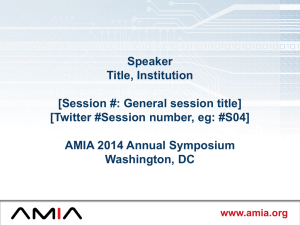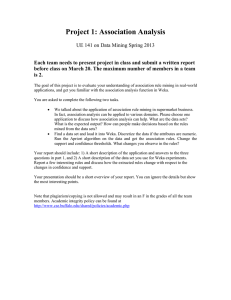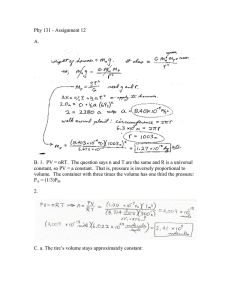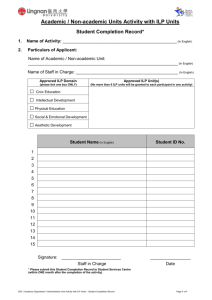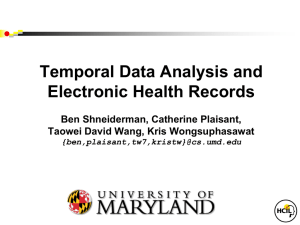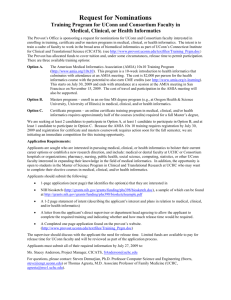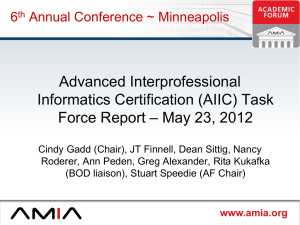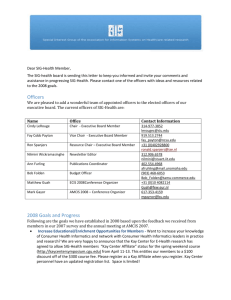dutra.amia11.slides...
advertisement
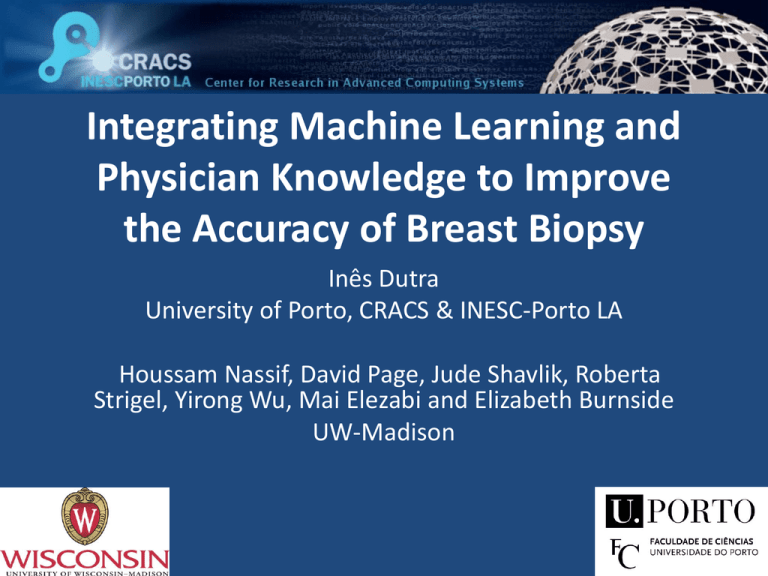
Integrating Machine Learning and Physician Knowledge to Improve the Accuracy of Breast Biopsy Inês Dutra University of Porto, CRACS & INESC-Porto LA Houssam Nassif, David Page, Jude Shavlik, Roberta Strigel, Yirong Wu, Mai Elezabi and Elizabeth Burnside UW-Madison Intro and Motivation • USA: ▫ 1 woman dies of breast cancer every 13 minutes ▫ In 2011: estimated 230,480 new cases of invasive cancer 39,520 women are expected to die • Source: U.S. Breast Cancer Statistics, 2011 AMIA 2011 2 Intro and Motivation • Portugal: ▫ Per year: ▫ 4,500 new cases ▫ 1,500 deaths (33%) – Source: Liga Portuguesa Contra o Cancro September 2011 AMIA 2011 3 Intro and Motivation • Mammography • MRI • Ultrasound • Biopsies AMIA 2011 4 Intro and Motivation • Image-guided percutaneous core needle biopsy – standard for the diagnosis of suspicious findings • Over 700,000 women undergo breast core biopsy in the US • Imperfect: biopsies can be inconclusive in 5-15% of cases – ≈ 35,000-105,000 of the above will require additional biopsies AMIA 2011 5 Intro and Motivation • Breast biopsies: –Fine needle breast biopsy –Stereotactic breast biopsy –Ultrasound-guided core biopsy –Excisional biopsy –MRI-guided AMIA 2011 6 Objectives • Hypotheses –Can we learn characteristics of inconclusive biopsies? –Can we improve the classifer by adding expert knowledge? AMIA 2011 7 Terminology • Inconclusive biopsies: “non-definitive”: – Discordant biopsies – High risk lesions • Atypical ductal hyperplasia • Lobular carcinoma in situ • Radial scar • etc. – Insufficient sampling AMIA 2011 8 Materials and Methods • Data collected – Oct 1st, 2005 to Dec 31st, 2008 • Tools – WEKA – Aleph • Validation: leave-one-out cross validation • Results tested for statistical significance AMIA 2011 9 Data source 1384 image guided core biopsies 349 M 1035 B 925 (C) 110 (NC) 43 (D) 51 (ARS) 16 (I) After eliminating redundancies AMIA 2011 94 10 Data distribution • 94 non-concordant cases went through additional procedures (e.g., excision) • 15 were “upgraded” from benign to malignant • Our population: 15+/79• Task: find a distinction between upgrades and non-upgrades AMIA 2011 11 Data Features biopsy procedure pathology priority abn. disappeared mass present pathology description asymmettry concordance architectural distortion mammography birads calcs ultrasound birads mass shape MRI birads mass margins combined birads mass density biopsy needle type calcifications biopsy needle gauge calcification distribution clip in site of biopsy mass size AMIA 2011 12 WEKA and Aleph • Data cleaning, single table • 15-fold stratified cross-validation (leave-one-out) • WEKA (Bayes TAN) and Aleph • Without expert knowledge • With expert knowledge AMIA 2011 13 WEKA and Aleph • Waikato Environment for Knowledge Analysis – Collection of machine learning algorithms and data mining tasks • use “propositionalized” data (flat table) • A Learning Engine for Proposing Hypotheses – Inductive Logic Programming (ILP) system – Knowledge representation: first order rules AMIA 2011 14 Method Learn rules about how and why non-definitive cases are “upgraded” Other rules (simple) provided by a specialist Combine New rules AMIA 2011 15 Modelling upgrades without expert knowledge • Aleph learning on the 94 cases (15+/79-) • Example of rule learned upgrade(A) IF bxneedlegauge(A,9) AND abndisappeared10(A,0) AND mass01(A,1) AND anotherlesionbxatsametime01(A,0). [4+/0-] AMIA 2011 16 Examples of Expert rules (1) Upgrade increases on stereo if calcifications and ADH are present upgrade(A) IF pathdx(A,atypical_ductal_hyperplasia) AND calcifications(A,’a,f’) AND biopsyprocedure(A, stereo). (2) Upgrade increases on US(Ultra-Sound) if high BIRADS category upgrade(A) IF concordance(A,d) AND mammobirads(A,4B/4C/5). AMIA 2011 17 Modelling upgrades with expert knowledge • Example of rule learned upgrade(A) IF numOfSpecimens(A,gt6) AND rule1_2(A) AND rule1_3(A). [3+/1-] rule1_2(A) IF pathdxabbr(A,adh) AND calcifications(A,f). [3+/4-] rule1_3(A) IF pathdxabbr(A,adh) AND calcification_distribution(A,g). [3+/6-] AMIA 2011 18 Results Classif. TP FP FN TN R P F Human Rules alone 9 45 6 34 .60 .16 .26 ILP 5 11 10 68 .33 .31 .32 Rules+ILP 8 13 7 66 .53 .38 .44 Weka 3 9 12 70 .20 .25 .22 Rules+ Weka 3 6 12 73 .20 .33 .25 AMIA 2011 19 Results Classif. TP FP FN TN R P F Human Rules alone 9 45 6 34 .60 .16 .26 ILP 5 11 10 68 .33 .31 .32 Rules+ILP 8 13 7 66 .53 .38 .44 Weka 3 9 12 70 .20 .25 .22 Rules+ Weka 3 6 12 73 .20 .33 .25 AMIA 2011 20 Results: WEKA versus Aleph and human rules AMIA 2011 21 Conclusions • Both WEKA and Aleph can improve results when combining original data with expert knowledge (without tuning) • WEKA improves on false positives and can be adjusted to achieve Recall of 100% with the need to re-examine around 60 women (out of 79) • Aleph improves on false negatives and produces a better classifier with the advantage of using a language that is easily understandable by the specialist AMIA 2011 22 Future Work • NLM project started this month AMIA 2011 23 Future Work • NLM project started this month • Short term tasks: – Augment the current dataset – Review consistently misclassified examples – Possibily use association rules to produce a first subset of rules AMIA 2011 24 Future Work • NLM project started this month • Short term tasks: – Augment the current dataset – Review consistently misclassified examples – Possibily use association rules to produce a first subset of rules • Medium term tasks: – learn from the cases that were not upgraded – Develop the iterative cycle of learning and expert rule revision AMIA 2011 25 Future Work • NLM project started this month • Short term tasks: – Augment the current dataset – Review consistently misclassified examples – Possibily use association rules to produce a first subset of rules • Medium term tasks: – learn from the cases that were not upgraded – Develop the iterative cycle of learning and expert rule revision • Long term tasks: – Use more sophisticated learning methods to produce better rules – To integrate biopsy attributes and the classifiers obtained AMIA 2011 26 to MammoClass (http://cracs.fc.up.pt/pt/mammoclass/) Acknowledgments • UW-Madison Medical School • FCT-Portugal and Horus and DigiScope projects • AMIA reviewers and organizers • Special ack to the UW-Madison Medical School people that were never “scared” of computer technology and have been always very enthusiastic about using computational methodologies to help their work AMIA 2011 27 THANK YOU! CONTACT: ines@dcc.fc.up.pt AMIA 2011 28 Experiment 1 Significance tests - p-values ILP Rules+ILP Rules+ILP Weka Rules+Weka P: 0.3437 R: 0.0824 F: 0.2007 P: R: F: P: R: F: P: 0.74 R: 0.43 F: 0.63 P: 0.32 R: 0.06 F: 0.18 P: 1 R:1 F: 0.80 0.74 0.43 0.63 0.32 0.06 0.18 Weka AMIA 2011 29 Experiment 2 tuning • 5x4 stratified cross validation • Parameters tuned: – Minacc: 0.05 and 0.1 – Minpos: 1, 2, 3 – Noise: 0, 1, 2 AMIA 2011 30 Experiment 2 tuning, best parameters per fold Folds 1 2 3 4 5 ILP rules alone minacc minp noise 0.05 3 2 0.05 3 0 0.05 1 0 0.05 1 2 0.05 1 0 AMIA 2011 ILP + human rules minacc minp noise 0.05 3 2 0.05 1 1 0.05 1 1 0.05 1 2 0.05 1 2 31 Experiment 2 - Results TP FP FN TN R P F1 ILP rules alone 4 13 11 66 0.26 0.16 0.20 Human + ILP 7 13 9 67 0.46 0.38 0.42 p= 0.3 0.03 0.1 AMIA 2011 32 Summary Precision-Recall Curve Human Rules + ILP ILP rules alone Human Rules alone WEKA-TAN ILP+tuning WEKA-TAN + Human Rules ILP+tuning+Human rules 1 0.9 0.8 Precision (PPV) 0.7 0.6 0.5 0.4 0.3 0.2 0.1 0 0.2 0.3 0.4 0.5 0.6 0.7 0.8 0.9 1 Recall AMIA 2011 33 UW upgrades data • 94 benign cases after biopsies were discussed • 15 considered to be, in fact, malignant upgrades • Tasks: – learn characteristics of upgrades that do not appear in non-upgrades interpretable rules – Can we improve the classifer by adding expert knowledge? AMIA 2011 34
